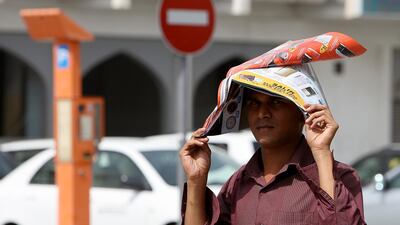Wladimir Koppen never visited Abu Dhabi or Dubai.
He probably would not have even been able to point out either place on a map.
Yet this Russian-German scientist, who died in 1940 at the age of 93, was the first to officially designate the climate of the region.
The Koppen climate classification, first published in 1884, identifies the UAE as desert – more specifically, as BWh, with the B representing desert and the W meaning low rainfall.
The h stands, perhaps unsurprisingly, for hot.
Everyone who lives here is familiar with the reality of BWh: long, hot, dry and dusty summers, marked by periods of extreme humidity and lasting from the end of May until October. This summer is no exception – even by the end of June, the thermometer had hit the high 40s in many parts of the country and a shirt-drenching 95 per cent humidity struck coastal areas.
This intense humidity is caused by the warming of the sea, which increases evaporation, with hotter land temperatures meaning the air absorbs more of this water.
We especially notice high humidity when it reaches the point where the air can no longer absorb more moisture, particularly our sweat. This disrupts the body's natural cooling process.
There are other consistent weather patterns in the region that we have already observed this year – cold fronts moving from the north, for example, draw up clouds of dust into the atmosphere. These are then blown to the UAE by prevailing winds as dust storms.
Forecasters warned last week of poor visibility caused by blowing dust and strong winds in Dubai and haze in Abu Dhabi.
More unusual were the periods of rain that accompanied the dust, which are the result of convective clouds forming.
An alternative way of measuring the seasons is with a traditional Al Drour calendar.
Dating back at least 500 years, it divides the year into four seasons marked by the visibility of certain stars.
Each season is identified with particular weather cycles associated with harvesting and fishing.
The calendar has three seasons of 100 days and a 60-day period of intense heat known as Al Qaiz. This includes all of July, the second half of June and part of August.
June was traditionally the height of the pearl harvest, with large fleets gathering at the oyster beds so divers could take advantage of the warmer seas. July is the time when dates ripen and are harvested. August brings the peak heat and the risk of storms at sea.
______________
Read more:
Think it's hot in the UAE? Spare a thought for muggy Montreal and boiling Belfast
How climate change could send household bills soaring, with the Middle East at risk
Special report: Abu Dhabi's dwindling water reserves charted in worrying Sorbonne research
______________
The tail end of August is when the Suhail star, also known as Canopus, becomes visible. It is the second-brightest star, after Sirius, and was named by Arab scientists in the 7th century. Bedouin used it for navigation.
First appearing low on the horizon, the significance of Suhail in Al Drour is that it marks a change of seasons, from the heat of Al Qaiz to Al Safri, the official start of the almanac.
Last year, Suhail was visible in the UAE for the first time in the third week of August.
The heat and humidity will still be here for a while, but for those looking for the first sign that summer is ending, the wait is only five weeks away.


